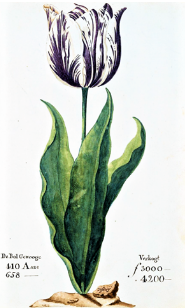For the Dutch version, click here.
Disclaimer: This article does not contain investment advice and only aims to inform and entertain.
This article discusses the very first economic bubble. For this we go back to the golden age (17th century). Originally, tulips did not originate from Holland at all, as many believe. They came to the Netherlands through the trade that the Netherlands conducted with Asia. Because of this, tulips were also seen as luxury goods. During this period, the Netherlands was very prosperous, thanks to this international trade, and interest in flowers increased tremendously. During the golden age, status was very important; to increase it, people bought expensive items, including tulips. The Library of Economics and Liberty wrote the following about this:
“It was deemed a proof of bad taste in any man of fortune to be without a collection of [tulips].”
Partly because of this, the demand, and eventually the price, only continued to rise. Because demand was so high, starting in 1636 it was possible to trade in tulips through the Amsterdam Stock Exchange. In 1637, the tulip price reached its peak; one tulip bulb had the same value as a canal house in Amsterdam. It was also possible to trade in options tulips.
Disadvantages of tulips
First of all, tulips are particularly fragile and must be grown carefully. Because there was a lot of money to be made in the tulip trade, many growers arose. These growers learned sophisticated techniques to promote the cultivation of tulips. There was even a technique discovered to make a tulip have different colors. These were rarer and therefore worth more money.
In addition, tulips did not contain an intrinsic value, which shares do. The intrinsic value of a stock can be calculated by reducing the company’s total assets by its total liabilities and then dividing this by the number of shares outstanding. This can be used to calculate whether a stock is overvalued or undervalued. This method is used by many experts, including Warren Buffett.
“What goes up must come down.”
Eventually, the tulip bubble burst at the end of 1637. People began trading in tulips using leverage; this involves investors borrowing money to realize returns. These investors often had other debts that they hoped to pay off by making possible high returns on the tulips.
When investors were forced to sell tulips to pay other debts, the market began to collapse. So as investors borrowed money to speculate in tulips, this happened very quickly and eventually the bubble burst. What seemed like an easy way to get rich ended in failure for many.
Relevance to the present
Although the tulip bubble burst almost 400 years ago, the event is still very relevant today. For example, Bitcoin today is regularly compared to this tulip mania. The price of the cryptocurrency is volatile and, like tulips, indeed lacks intrinsic value. In both 2017 and 2021, the value of the cryptocurrency rose unprecedentedly hard only to fall again at least as hard. There are a number of similarities between tulips and Bitcoin. According to Pichet, E (2017) and Taskinsoy, J (2019), both tulips and Bitcoin were only used to speculate. Individuals purchased tulips for the sole purpose of selling it for a higher amount without making rational considerations, the same was true for Bitcoin. Still, there are some differences. First, Bitcoin is scarce, which cannot be said about tulips, which can be grown at any time. In addition, the cryptocurrency is based on the Blockchain.
Conclusion
The likelihood of a similar bubble occurring in the future will always remain significantly high. People will continue to strive for high status and therefore are looking for a quick way to make money. Thanks to the advent of the Internet, bubbles form a lot faster and as long as people continue to act irrationally, bubbles will continue to form.
There are some wise lessons investors can take away from this bubble:
-
Always remain rational. As discussed, financial bubbles occur because people make irrational decisions and, as a result, begin to speculate in investments that they themselves do not understand. As a result, individuals can react emotionally to price changes and subsequently lose a lot of money.
-
Be less concerned with status and don’t compare yourself to others. Instead, it is better to focus on your own (financial) situation.
-
If an investment seems too good to be true, it probably is.
-
Don’t just borrow money to invest. This makes an investment unnecessarily risky and can have negative consequences as the tulip bubble shows.

















